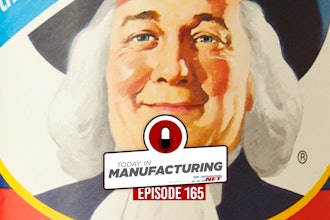Small and midsized manufacturers (SMMs) are a driving force in our nation’s economy. They represent more than 99 percent of the U.S. manufacturing industry and account for 40 percent of U.S. production value. Faced with mounting evidence of an economic slowdown and strained credit market conditions, however, it is important now more than ever for SMMs to maintain growth rates and remain globally competitive. It is imperative to create a culture of innovation and continuous improvement.
American manufacturers continue to lead the world in innovation, as evidenced by higher R&D expenditures and higher utilization of nanotechnology in manufacturing than other countries. Innovation is not only the development of new products and product line improvements, but also the introduction of new technologies and improvements into the manufacturing process.
Often, a new manufacturing process is the precursor to a new product that can be commercialized for the marketplace. But that lead is being threatened as rapidly advancing globalization of supply chains and rising education levels internationally have slimmed the U.S. manufacturer’s advantage. Internal challenges abound as well, including a lack of senior management buy-in to the innovation process, poor understanding by employees of the repercussions of sub-par quality, and the absence of community college and other training partners who can help build employee skills.
In addition, the ability of a manufacturer to produce consistently to cost, quality, and delivery objectives is becoming even more critical to the organization’s ability to compete effectively in a globalized marketplace.
Despite the fact that developing lean strategies allows SMMs to differentiate themselves from their competition through customer value, SMMs have been slow to adopt. The reluctance of small and midsized manufacturers to apply lean principles undermines their bottom lines. U.S. plants that have implemented at least one of the lean approaches report a median 35 percent gross profit margin and $197,000 sales per employee, versus just 31 percent gross profit and $150,000 for those not implementing lean.
This “lean gap” faced by small and midsized manufacturers is especially surprising because lean is an approach that small companies can afford, requiring them only to understand the processes, identify wastes, address the root causes of problems, and then improve the process with available resources.
The assumption that lean manufacturing causes workforce cuts is a misconception. Companies implementing lean processes have found that as operations become more efficient, the firm can redistribute workers into new areas, keeping staff employed and growing a cross-functional workforce in the process. Ideally, increased value for customers and more nimble responsiveness leads to new business opportunities and increased capacity.
Within the new global value chain, OEMs and major suppliers are pushing the responsibility for innovation down to smaller companies. SMMs need to be prepared to provide design capabilities on the front end and delivery responsibility on the back end, where in the past SMMs merely produced to specification. This requires investment in the resources necessary to provide these capabilities for customers.
Creation of this innovative environment is where some SMMs are being successful today. It’s these companies that are generating new ideas, modifying current products, entering into new markets, and differentiating themselves from the global competition. American ingenuity continues to be the driver of innovation.
RSM McGladrey recently co-authored and sponsored a report with the National Association of Manufacturers (NAM) and The Manufacturing Institute on SMMs that identifies pressing challenges for the industry. It concludes that SMMs must adapt for success and provides best practices for harnessing innovation:
• A better-informed team. As products change, employees need to understand what would happen if new products are not produced correctly. Company-wide education in lean methodologies and principles should be paramount.
• A rewarded team. When employees excel with innovative ideas, they deserve recognition. This will foster champions who will lead the charge to develop new products, improve performance and ensure successful processes are integrated throughout the company. Small and midsized manufacturers vary in how they recognize their top performers, from cash bonuses to days off with pay and companywide recognition.
• A better-informed customer. It’s important to communicate with primary customers about lean experiences and new roles in innovating. Customers should understand that at times they need to share risks and costs for new product development if it is to be a successful partnership. The new value chain works best when there is that kind of trust and mutual support within the chain. Many small and midsized manufacturers report that this is too often missing.
• A high-tech college partner. Local colleges, universities, and technical schools can provide tremendous assets for small and midsized manufacturers with new innovation mandates, especially when the local college has technological capabilities that the company does not have.
Improvement and innovation go hand in hand. Lean and other improvement approaches enable companies to innovate how they do what they do. But companies must not forget to innovate the who and the what. A culture of innovation should permeate the company, fostered by CEOs who reward fresh ideas and risk-takers.
Every SMM embarking on a lean initiative should have a plan for how it will leverage its freed-up capacity and working capital to improve growth — whether this is introducing new products or entering new markets.
In today’s dynamic markets, innovative leaders find ways to deliver new, high margin, value-added services to their customers. Maintaining and fostering a skilled workforce — which advances lean initiatives — will ensure that SMMs can successfully navigate a competitive global marketplace.
RSM McGladrey is a professional services firm providing accounting, tax and business consulting to middle market companies. For more information visit www.rsmmcgladrey.com






















